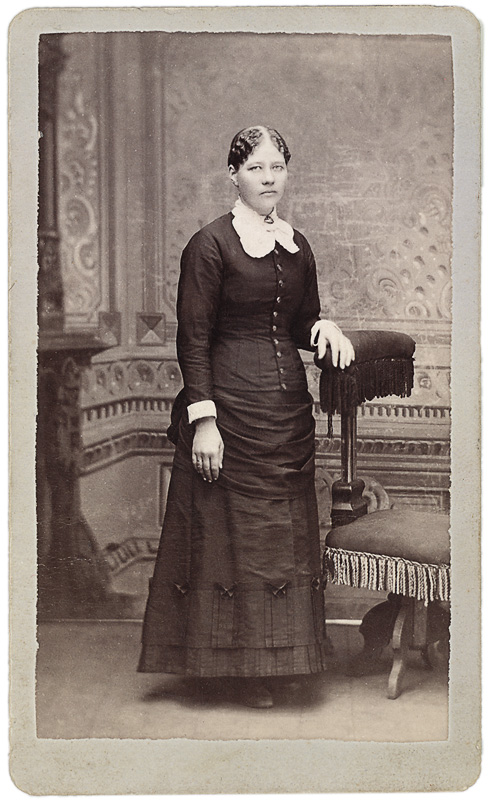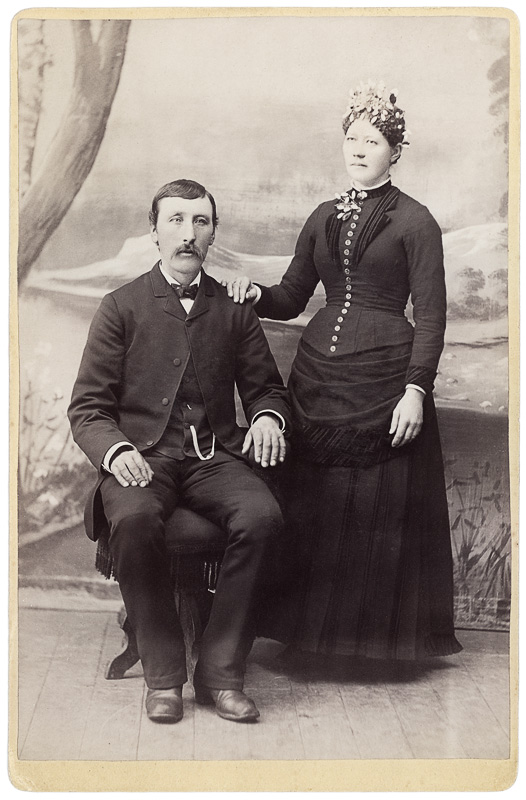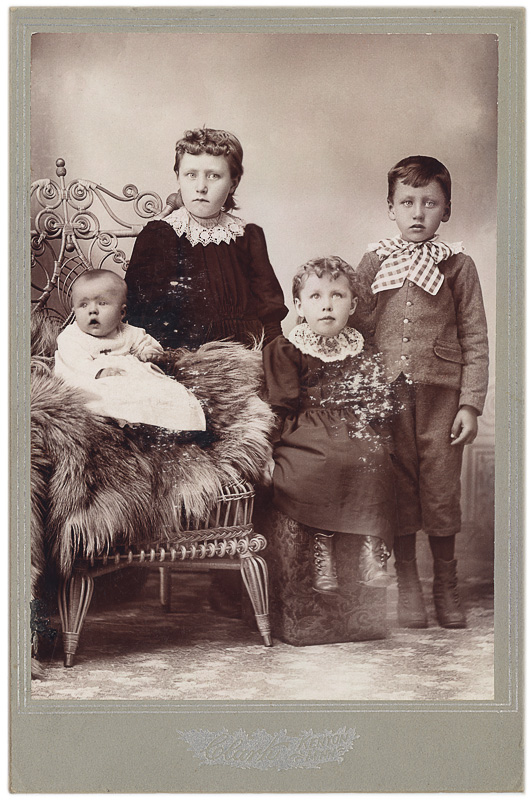
ANDERS BRATTEGJERDE
Anders Brattegjerde was born Jan. 16, 1853 to Ingvar and Ingeleiv Brattegjerde in Laerdal, Sogn, Norway and died July 16, 1916 in America. They were a very poor family. I do not know his father's occupation, but he was called a husmann. They owned their house, but they paid in labor for the land the house occupied. They lived where it was very steep and the fences were steep as well. This was how the Brattegjerde name originated. Anders was the third of six children. He attended some school and learned to read and write. Grandfather was baptized and confirmed at Laerdal's Kirke. Norway had compulsory military training and he was in the service for a period ofabout three months. He also worked on highway building - Kong's Veien. His job was blasting rock in the mountains. Primogeniture was prominent and so the younger children each learned a trade in as much as they would not inherit any property. Grandfather learned the shoemaker trade.
In the spring of 1880 he came alone to the United States. He went by boat from Sogn to Bergen and then boarded another boat to cross the North Sea bound for Liverpool, England. From there to Hull, England, he traveled by train. Then, at Hull, he boarded the Cunard Line steamship and docked near Philadelphia. He took the train to Rising Sun, Wisconsin(Crawford Co.) to his uncle's farm - Ole Olson. He stayed there for about a year and worked as a farm hand, but he sought more adventure and so he left for Zumbrota, Minnesota via the Smalspor, the Milwaukee Road, to visit a distant relative - Lasse Tonjum. He worked on neighboring farms and while working for Nels Einar and Kjistina Lunde, he met his future wife who also worked there.

GURI OLSDATTER QUAALE
Guri Olsdatter Quaale was born March 17, 1858 in Vang, Valders and died on Oct. 11, 1953 in America. Her grandparents, uncle and mother (Ole, Guri, Agrim & Ingeliev) moved from Borgund (adjoining part of Laerdal) to Vang, Valders in 1856. Here her grandfather had a mill that ground grain for the community. They were a very poor family and the chief constituent of their diet was bread made from tree bark and flour. Guri's mother cared for the cows and took them to the mountain pasture (Saeter) during the summer months where she made butter and several kinds of cheese. This was part of their food for the winter months. Guri's mother, Ingeliev also spun yarn, dyed it, wove the fabric and made all their clothing. When my grandmother was 11 years old she and her godmother (Berit) took the cows to the Saeter because her mother was busy
preparing for their journey to America. Grandmother attended school in Norway and especially liked geography.
In the spring of 1870 Guri, Ingeliev and perhaps Guri's grandfather Ole began their journey to America. They traveled from Vang to Laerdal on the Filefjell road by horse drawn vehicle stopping several times to change transportation or say good-bye to friends and perhaps give them a small gift. At Laerdal they boarded a boat which took them to Bergen. There they took another boat to Liverpool, England and then by train to Hull.
At Hull they boarded a steamship which took them to Quebec, Canada. They were on the ocean for about three weeks. Ingeliev was seasick, but my grandmother Guri had fun. They had brought their own food - flatbrod, cheese, dried beef and butter. Their accommodations were very poor because the quarters had been previously occupied by sheep. At Quebec they boarded a train that brought them to the United States. They crossed the Great Lakes by ferry, passed through Chicago before it burned and went by train to LaCrosse, Wisconsin. From there they took a flatboat by night to Red Wing, Minnesota arriving at daybreak. It was now early May. They were met by the hotel keeper who took them to the hotel and fed them a good meal with coffee. He also found a ride for them because farmers were hauling grain to Red Wing and would always stop at the hotel. They rode with a Mr. Sevareid who was the grandfather of Eric Serareid, well known network anchor for many years. The ride was very rough sitting on the floor of the wagon box. They walked the two miles from the Sevareid farm to my grandmother's uncle and aunt's farm (Agrim & Marita Broin).
They made their home with the Broins. Marita was ill and so Ingeliev cared for her, the home and the animals. They had one daughter, also named Guri. My grandmother Guri spent much time working for her cousin Guri and her husband Jens Broin. They had eleven children. The Broins were typical Goodhue County pioneers. Grandmother and her mother would work as one worker bundling grain at harvest. It was very hard work, but also very good pay. - $3.00 per day. Their chapped hands and legs were greased with sheep tallow each evening. Grandmother went to school for one year to learn the English language. She was confirmed by Pastor B. J. Muus at Holden Church. The classes were held at the parsonage and she walked four miles to get there. She carried her lunch and stayed all day and would walk home after dark. Seventy students were confirmed with her. After confirmation she worked in Zumbrota as a maid for a Yankee family. Later she learned the dress-making trade in Zumbrota and bought a Singer sewing machine. Following this she worked for the P. L. Berg family in Kenyon doing baby-sitting and domestic duties. Later she worked for Nels and Kjistina Lunde as a hired girl and here she met her future husband.

MARRIAGE AND FAMILY
On Oct. 19,1887 Guri Olsdatter Quaale was married to Anders Brattegjerde. They were 29 and 34 years old respectively. Only closest relatives were present for the simple ceremony at 11 :00 A.M. at Holden Church with B. J. Muus as the pastor. They had no attendants. The ceremony was similar to a Sunday morning worship service except that the bride and groom sat in the front pew. Then, during the sermon they stood before the altar and following the sermon their vows were exchanged. Both had gold band wedding rings, but later my grandfather traded his for a pocket watch. Grandmother's dress was made from brown woolen fabric and grandfather's suit was black. Grandmother's cousin Guri, for whom she had worked so much, prepared a goose dinner for the bridal couple and their guests. They received gifts such as dishes, a bedspread, linens, a rocking chair, a cow and a hymnbook. They continued working for the Lunde's until Spring.
In the Spring of 1888 they bought 80 acres of land in the Spring Creek community in the vicinity of what is now Bombay for $20 per acre. They had no machinery of their own for a couple of years and so their neighbors worked the land and furnished the seed and my grandparents received a part of the crop, which in this case was very little because of the grasshoppers and the chinch bugs. My grandfather worked for neighbors who had bigger farms. The money that he earned he put into improvements and gradually bought a plow, drag, mower and wagon. The purchase of a grain drill and binder came years later. In the Spring of 1894, they built a small frame barn with an attached chicken house. In the Fall of the same year, they built a frame house, 18 X 26, one and one-half stories high. They bought the lumber and had to borrow some money for the construction costs. By this time there were three children - Inger, born Aug. 21, 1888, Ingvar, born July 19, 1890 and Ida (mother), born Dec. 13, 1892.

May 3, 1895 brought tragedy. Lightening struck and the barn, together with some livestock and chickens burned. My mother remembered the bucket brigade by neighbors attempting to save the burning structure. By Fall they had a new barn which was a little bigger than the first and soon they replaced their livestock and were able to pay their debt. Three more children were born, Lena born Mar. 1895 and died Jan. 1, 1896; Oscar born Dec. 30, 1896, and Anna born April 22, 1900. By the turn of the century they had dug a new well, put up a windmill and planted a grove of evergreens.
Perhaps the main characteristic of the family was their thriftiness. Their food was very simple, but they had plenty. They bought most of their groceries in bulk and traded wheat for flour at the mill. They had a garden but did not can vegetables. They canned apples from their orchard, strawberries and pickles. During the winter months they would butcher both beef and pork and preserve the meat by canning, salting, smoking or drying it. They churned their own butter and put it into molds for special occasions such as Christmas.
The children were permitted to go along to Kenyon once during the year - usually when they were going to get new shoes. It was a big treat to go to town. All their clothes were home-sewn - some from home woven fabric and some from purchased fabric. Grandfather always repaired the shoes. They also made their own soap. Lye for soap making was made by running water through a barrel of ashes and then boiling it together with tallow. The soft soap was kept in a barrel for scrubbing purposes, while the hard bar soap was used for clothes washing, dishes and personal use.
Worship services were held every other Sunday in Holden Church. Usually the whole family attended. When they did not have church, grandfather would read from the Huspostil- a book which contained a sermon for every Sunday. Then grandmother and great-grandmother would sing familiar hymns. This became quite lengthy for little children. It was a custom in the church during that time that men and women were segregated. The women and the smaller children sat on the left side, while the men and the older children sat on the right side.
They lived over two miles from the small country schoolhouse. In the Fall they would have two to three months of Norwegian parochial school which was followed by six months of regular school. Usually the congregation provided the teacher for parochial school. He also served as the Klokker who read the opening prayer, announced the hymns and prayed the closing prayer in church. Usually he was a seminary student who had taken off a year to earn some money and would cover four districts during the year. He boarded for a week or so at each home and then was paid by the parents and others who were interested. After the Bombay store came into existence, school children with extra coins would ask the Brattgjerde children to purchase candy for them and bring it to school the following day.
At Christmas the family had a decorated tree. There were very few candles on the tree because it was such a fire hazard. Popcorn strings provided part ofthe decoration and then they would hang little presents such as handkerchiefs and candy on the tree also. The larger packages were under the tree and were opened Christmas Eve. Most of them contained homemade clothing. Christmas food included such things as cookies, lefse, fattigmann, raisin bread and apples. They always had an afternoon Christmas program at the church. The windows were covered to make the church dark to enhance the beauty of the candles and other decorations. An offering was received and treats were distributed to everyone.
Several cousins immigrated from Norway. Each had learned a trade and soon found work, but for Sundays and holidays they almost always gathered at the Brattegjerde home. Children of the family enjoyed seeing the cream hauler come, watching him test the cream and emptying the cream into huge cans - the sweet and sour together. He did not weigh it, but used a measuring stick to determine the amount.
About 1901 the Milwaukee Railroad was built past their farm. Mule teams and scrapers were used for moving the dirt to form the railroad bed. Everyone found it interesting to watch the crew laying ties and spiking rails. During this time of construction, Anna was a toddler and my mother(Ida) was assigned the duty of keeping her at a safe distance. The old granary which was in the path of the railroad, had to be torn down and a new one was built. Finally the big event - great excitement as the first train arrived. With the railroad there came many hobos and many lunches were given to these beggars. Soon a little trading center (Bombay) developed adjacent to the farm. It included a railroad stop, a cheese factory, a general merchandise store, an elevator, a blacksmith shop and a stock yard. The beginning of Bombay became a source of communication with the outside world, a convenient shopping place for the family and an opportunity for travel to other communities. My mother rode the train to and from Kenyon weekly while attending high school. They also used the train to visit relatives in Faribault and Zumbrota.
The children were growing up. Guri's mother, Ingeliev, had come to make her home with them in 1894. She was well integrated into the family circle. She assisted with the chores, especially helping care for little calves and pigs. She also helped with the domestic duties such as knitting socks and mittens, mending, spinning yarn and weaving fabric for clothing and bedding. She taught her granddaughters knitting, and also helped them learn little verses and prayers. Each day after the noon meal, she took the left-over potatoes and made pote-kake, which constituted their afternoon lunch. On her 85th birthday, July 2, 1916, the family had a party for her. Guests included her only niece, Guri Broin and her children together with their families. In 1914 the Brattegjerde family bought an additional 40 acres of land and built a new addition to the house.
In 1916 misfortune came again. Grandfather fell from a hayload and was severely injured. He died on July 11. Grandmother and the children continued farming. Then in the Fall of 1917 my great-grandmother, Ingeliev, was picking apples in the orchard. As she reached upward, she stumbled on a ladder lying hidden in the grass, fell and fractured her hip. She died Oct. 19, 1917 and was buried at the Holden cemetery next to her son-in-law Anders, and granddaughter Lena. Grandmother stayed on the farm until 1933 and after that she made her home with her children. She died Oct. 11, 1953 at age 95. She had sold her farm to her'oldest son Ingvar. He continued to live there, farming the land until his death. The property is now owned by a Brattegjerde grandson, Alfred Huseth.
Remembrances - Imogene Boyum Nelson
July 24, 2003
Submitted by: Kenley Boyum, Goodwin Boyum, Imogene Boyum Nelson
Children of Ida Brattgjerde Boyum